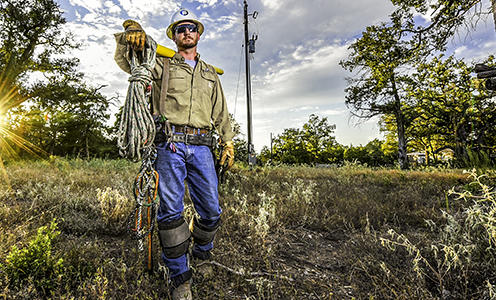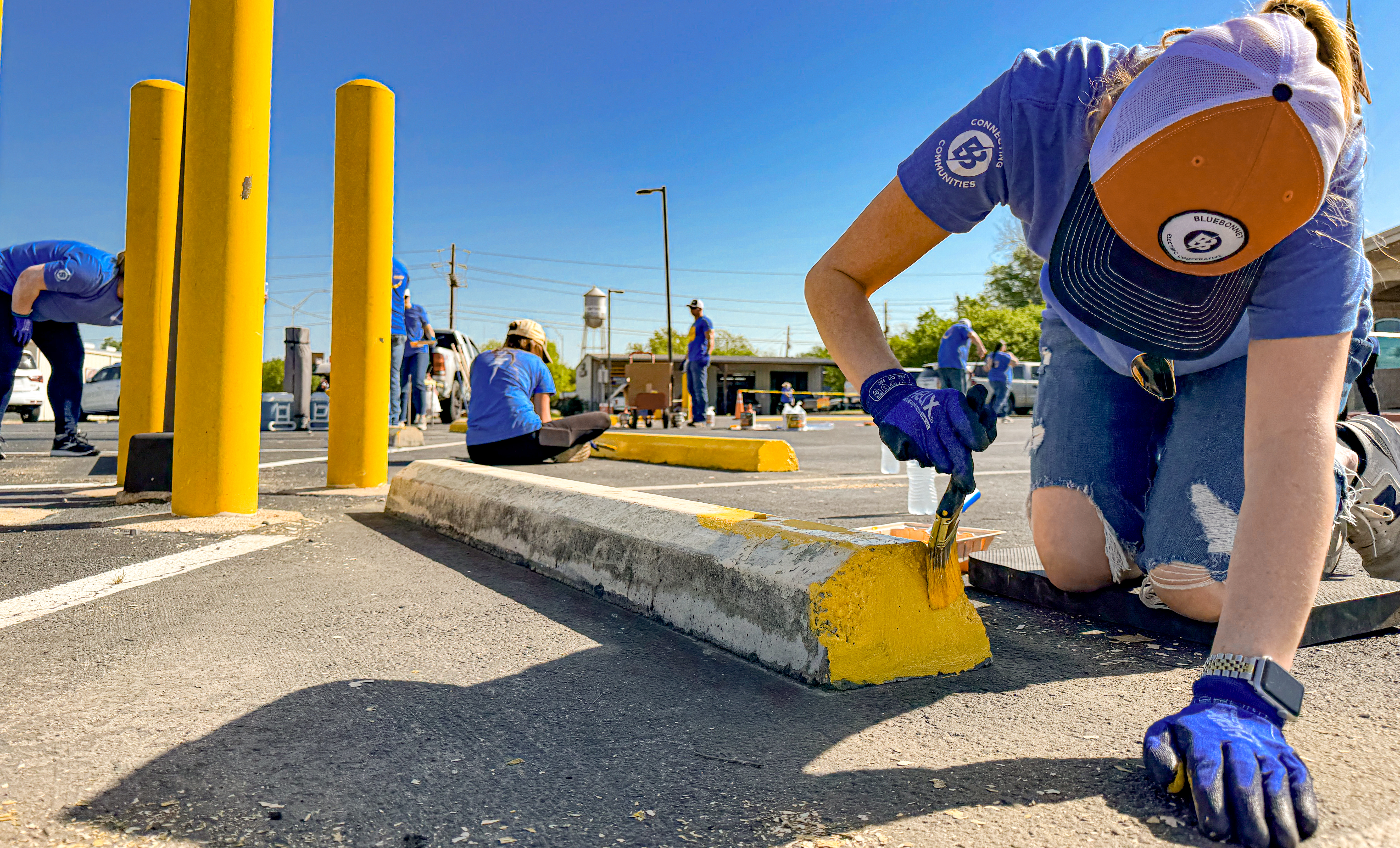The cooperative way
Recent news
Bluebonnet Electric Cooperative and LCRA representatives present a $10,000 grant to the Winchester Area Civic Association for improvements to Zilss Memorial Hall. The grant is part of LCRA’s Community Development Partnership Program. Pictured in the front row are, from left, Ellen Brumback, association secretary; Barb Schafer, association member; Margaret D. "Meg" Voelter, LCRA board member; Byron Balke, Bluebonnet Board assistant secretary/treasurer; and Dinah Breeden, association vice chairman. Second row, from left, Margaret Atkins, association treasurer; and Michele Weth, association member. Third row, from left: Rhoda Gersch, association member; Pat Karisch, association past president; Bill Karisch, association member; Sherry Murphy, Bluebonnet Giddings-area community representative; and Liz Wallace, association member. Back row, from left, Nicolette Morrison, association president; Sherwood Gersch, association member; Kate Ramzinski, LCRA regional affairs representative; Russell Jurk, Bluebonnet Board member; Richard Schafer, association member and co-project manager of renovation; Matthew L. “Matt” Arthur, LCRA board member; and Tom Atkins, association member and co-project manager of renovation.
Zilss Memorial Hall soon will receive much-needed improvements to its nearly 100-year-old building, thanks to a $10,000 grant from Bluebonnet Electric Cooperative and the Lower Colorado River Authority.
The Community Development Partnership Program grant, along with $4,238 in matching funds from the Winchester Area Civic Association, will enable renovations to a restroom to comply with the Americans with Disabilities Act, constructing a closet and adding attic insulation. The association also will rebuild an ADA-compliant ramp into the building and purchase two air conditioners and a refrigerator.
The hall, built in the 1930s as a schoolhouse, later became the cafeteria for the nearby high school. The building was converted to a facility for public use after the Winchester public school closed in 1949. Emil Zilss, one of the leading merchants and early residents of Winchester, donated the building to be used as a community meeting place.
“The building was used for weddings and receptions when it first became a community hall,” said Rhoda Gersch, a WACA member who has held various officer positions over the years. “We have heard stories from some community members who were married in the hall, and in at least one instance, the weather was so cold that they decided to just spend their wedding night there instead of braving the cold to go back home.”
After members of the community officially created the Winchester Area Civic Association in the 1960s, association members made upgrades such as installing air conditioners and renovating the kitchen. The upgrades made the hall a place for Fayette County gatherings for decades.
“We still have wedding receptions there, but now there are so many events and uses for it,” Gersch said. “We recently started a farmers market, and we regularly have birthdays, wedding showers, and baby showers, and the fire department has its annual meeting and Christmas party there.”
WACA continues to host community events at the site.
“We have an annual community party at Christmas with Santa, a Spring Fling with the Easter Bunny, and a Taste of Winchester where we ask people to bring their favorite cooked dish to share with others, as well as to enter in a contest,” Gersch said. “And we can’t forget our bimonthly Young at Heart get-togethers, which are so important in some people’s lives, when about a dozen people bring a little meal and play dominoes or cards for three hours.”
The hall also is home to classes and events for the Quilt Block Trail of Winchester, which was created by Gersch and fellow resident Margaret Atkins. All proceeds from the group’s classes and sales of quilt blocks benefit the WACA. The group’s main fundraiser is a popular domino tournament with a fried chicken dinner that helps pay some of the hall’s bills, but primarily goes to providing scholarships for Fayette County students.
“We are so pleased we can make these upgrades with the grant money to keep this hall in use for many more years, because Zilss Memorial Hall is a place where people come for fellowship with their neighbors, and it’s been that way for a long time,” Gersch said.
The community grant is one of five grants being awarded by Bluebonnet and LCRA through LCRA’s Community Development Partnership Program, which helps volunteer fire departments, local governments, emergency responders and nonprofit organizations fund capital improvement projects in LCRA’s wholesale electric, water and transmission service areas. The program is part of LCRA’s effort to give back to the communities it serves. Bluebonnet Electric Cooperative is one of LCRA’s wholesale electric customers and is a partner in the grant program.
Applications for the next round of grants will be accepted in January. More information is available here
Today’s bullfighters skip the face paint and silly clothes for the serious business of protecting riders in the rodeo ring
Story by Pam LeBlanc -- Photos by Laura Skelding
If a snot-slinging, 1,500-pound hunk of muscle and rage hurtled across an arena in your direction, would you run toward it or beat a hasty escape?
Your answer could determine whether you’d make a good bullfighter, the term now used in the U.S. and Canada to describe the rodeo athletes who distract bulls and protect riders during bull-riding competitions.
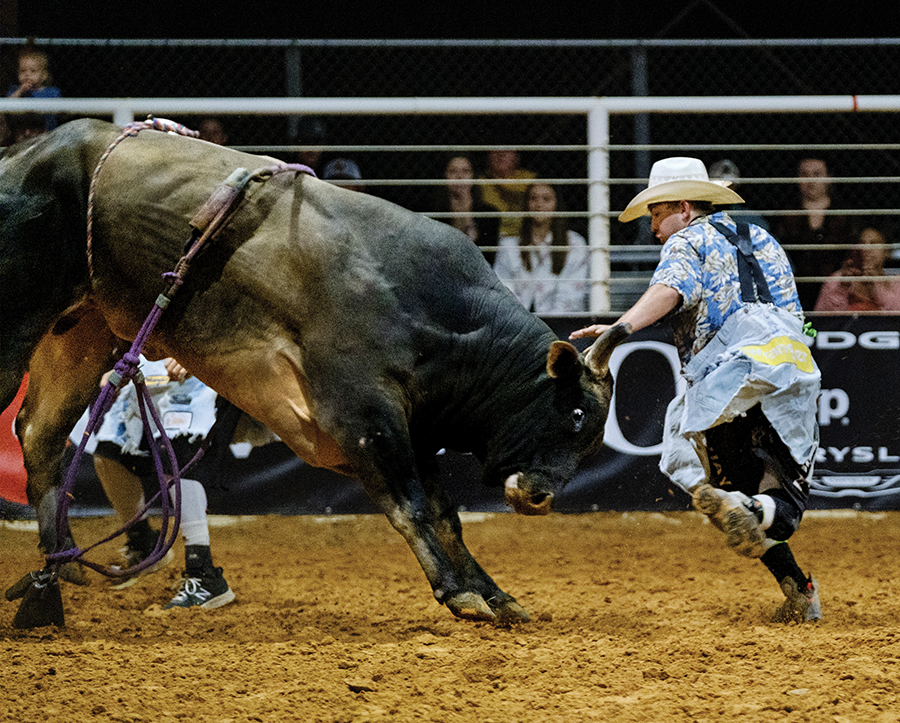
They used to be called rodeo clowns, but there’s not much that’s funny about working under such dangerous circumstances.
“The Secret Service protects the president. We’re there to take the bullet instead of the cowboy,” said Wesley McManus, a former bullfighter who now owns Diamond Cross Rodeo Company, a Lexington-based contractor that provides bucking horses for rodeos across Texas. “In the moment, you just go in there and step in between the cowboy and the bull.”
McManus, 50, spent 20 years tangling with the angry Volkswagen Beetle-sized beasts.
“It’s like jumping out of a plane,” he said. “A lot of people don’t see the reason for it. But there’s that rush, that feeling- — there’s nothing like it. It starts a fire inside you, and then it turns into a passion for the sport of rodeo and the whole Western way of life.”
Learning the ropes of bullfighting
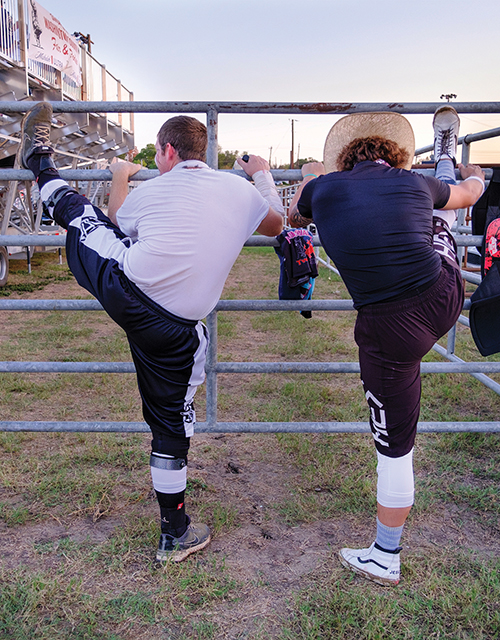
McManus grew up in Lexington in Lee County and did some bull riding in high school. He eventually decided he was better at helping cowboys get away from snorting bulls than trying to ride them. Plus, the paycheck was steadier: Bullfighters typically earn between $200 and $2,000 per show, according to the Bureau of Labor Statistics. He started learning when he was just 18.
“I told my mom and dad when I was 5 that I wanted to go to rodeo clown school. They thought it was cute until 12 years later when I was still saying it,” McManus says.
Some who do the job still wear greasepaint and bright clothes, but many don't. Instead, they wear technical jerseys and often belong to the International Professional Rodeo Association.
Skills essential to the job are “reading cattle and anticipating where the rider is going to come off,” McManus said.
McManus got his start as a bullfighter at a small Sunday afternoon rodeo in Lexington and eventually worked his way into bigger gigs. Mark Goodson, now chairman of the Lee County Sheriff’s Posse Rodeo, gave McManus his first big bullfighting job at a Youth Rodeo Association event at the arena in Giddings.
“You see the ‘want to’ in guys like Wesley,” Goodson said. “He was a natural.”
Some people enroll in bullfighting training classes, such as those offered around the country by famed bullfighter Cody Webster, who this year offered classes in San Antonio, Fort Worth, Cleburne and Arlington. Webster is considered one of the greatest bullfighters of this generation. Clinics are also offered in New Caney, near Houston. Others just practice skills on their own or at places like Bad Dog Rodeo in Belton, which offers a practice pen for up-and-coming bullfighters.
McManus is mostly self-taught.
He started by sorting calves and paying attention to which hoof an animal leads with while running. That “lead” telegraphs which direction the bull is likely to pivot, tipping off bullfighters which direction to move.
“A lot of it is natural reaction,” McManus said. “You can’t teach anybody how to be cattle savvy, and you can’t teach heart, but you can sharpen skills.”
Typically, two or three bullfighters and one barrel man (the athlete who hops into a padded barrel at which an angry bull charges) position themselves on either side of the bull when it bursts out of the chute and into the arena.
The rider has to stay on the bull for at least 8 seconds to earn points. They sometimes get a hand caught in the rope they hold to stay in the saddle. When that happens, the bullfighter works the rider’s hand loose, then draws the animal away from the rider when he finally lands on the ground.
“When that rider gets hung up, they’re depending on you to get them out of a jam,” said Goodson, the rodeo chairman. “You’re going to get hit and hurt. It’s a matter of how bad.”
And it can get bad.
“When you get run over, you’ve got four feet coming at you. You’ve got to worry about getting back up, because he’s probably coming back for you,” McManus said.
McManus recites a list of injuries he has suffered during his career: a blown-out knee, broken ankle, cracked ribs, dislocated fingers and plenty of stitches.
One memorable day, a rampaging bull stepped on his face and broke his teeth. After that, he said he prayed: “If I’m not supposed to do this, take the want away.” But the desire to be a bullfighter didn’t fade. “When I came back, I was on fire,” he said.
Eventually McManus retired, shifting his focus to the business of providing livestock to rodeos.
Like father, like son
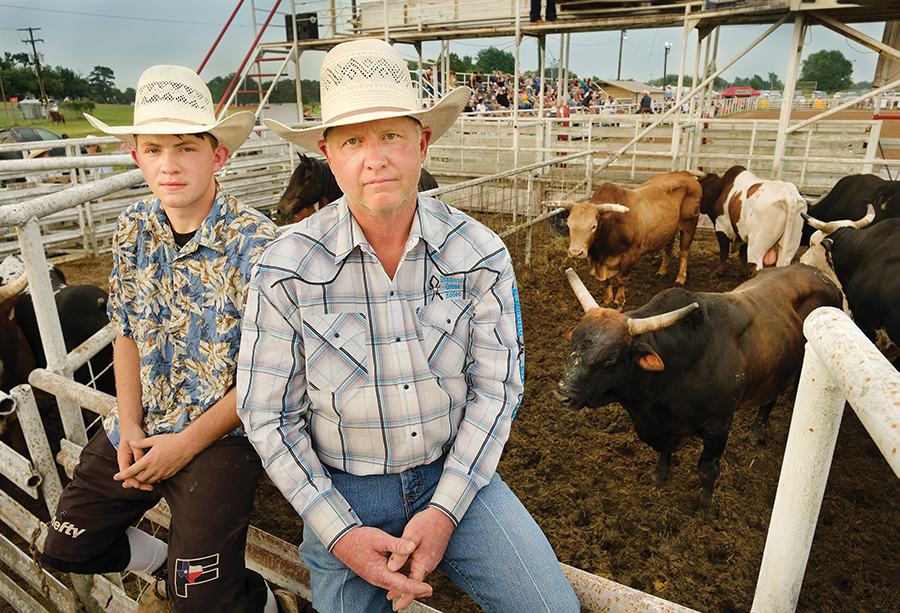
A generation later, McManus’ son is following in his father’s footsteps. Like his dad, Dylan McManus knew early on he wanted to become a bullfighter.
“We tried to keep him away from it as long as we could,” Wesley McManus said.
The fear he now feels as a parent watching his son in the ring far exceeds the fear he endured in the arena while facing a bull, he said.
“I love it when young guys come in, but you’ve got to be really serious,” Wesley McManus said. “You can get hurt. We’ve lost a few. If you’re out here for the girls, you’re in it for the wrong reason.”
Dylan, 18, started bullfighting almost three years ago.
“My dad was really good when he did it and I looked up to him and his buddies as role models,” Dylan said. “I guess it’s always been in my heart to do it.”
He started at age 9, working with his father to sort calves in pens at his home. “We’d go to the sale barn and buy something little that was pretty mean,” he said. “I would learn the fundamentals with something that wasn’t big enough to hurt me too bad.”
That evolved into bullfighting at small events, which led to working at larger events like the Cowboys Professional Rodeo Association Finals in Angleton, near the Texas Gulf Coast, and the San Antonio High School scholarship finals at the San Antonio Stock Show & Rodeo.
Now Dylan wants to make a career of it.
“There’s nothing like making a good (cowboy) save and they get up and shake your hand and they say thank you,” he said. “There’s nothing like knowing you’ve got somebody’s back.”
The hard part is pushing fear aside. “You’ve got to take control over your mind and not be afraid of what’s going to happen,” he said. “It’s really hard to make yourself go up to a big animal that’s trying to hurt you.”
When done right, though, it’s a rush like no other.
“You’ve got to have three (extra) sets of eyes. You’ve got to know when (the cowboy’s) going to fall, where the bull’s going to go, where your partner’s going to go and where you’re going to go,” he says. “That’s a lot of timing and calculation, and it happens so fast. It’s basically fight or flight.”
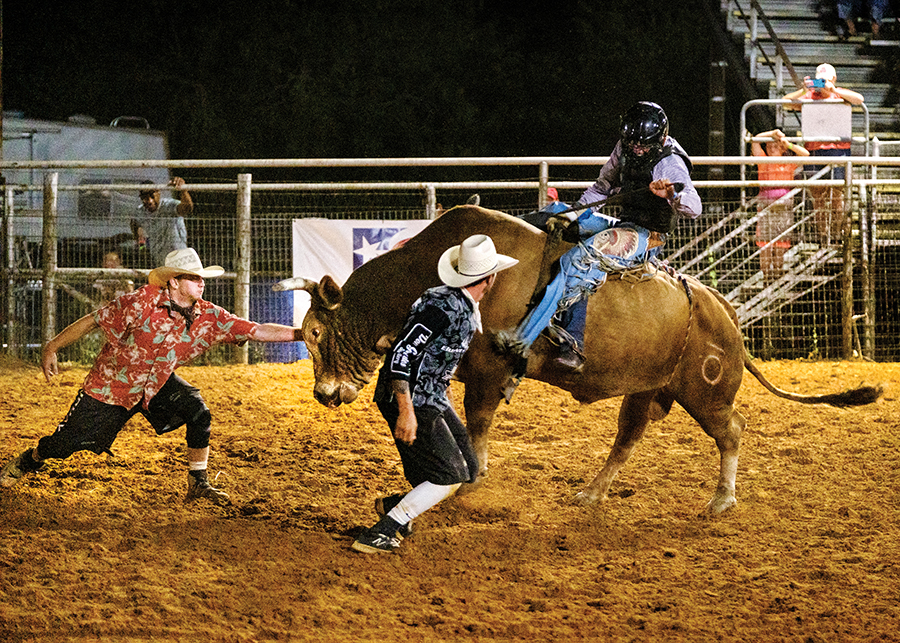
That’s why a good partner matters, and for Dylan McManus, that person is Dakotah Teague. The two team up often, and worked the Cowboys Professional Rodeo Association Finals this summer, where both bullfighters got up close with thrashing animals. McManus had to grab a bull’s head to distract it from a bullrider, and Teague took a couple of hits. He described the experience as similar to what it might feel like standing in front of a car going 15 mph.
“It helps a lot more when you trust someone on the other side of the bull to save not only the bull rider, but yourself if you get down. It’s a brotherhood, that’s what it is,” said Teague, 31, who started bullfighting when he was in high school.
Teague honed his skills at a bullfighting clinic with well-known bullfighter Cody Webster, then started working rodeos a decade ago.
Because injuries are common, the bullfighters wear vests plated with thick plastic that can make an errant hoof slide off and help distribute the impact of a kick over a wider area. They also wear knee and ankle braces. Dylan McManus doesn’t wear a helmet — “Just my old black felt cowboy hat” — but he does lace up basketball shoes before he heads to the arena.
“It’s hard to run in boots,” he said.
The camaraderie and connection among athletes keeps them coming back. It’s a family, they say.
“Oh, we love the sport,” Teague said. “We love what it’s all about and we love protecting cowboys. We always say we want the cowboys to go home safe to their families before we do.”
Want to watch the bullfighters?
Catch all major rodeo action across the Bluebonnet Electric Cooperative service area in 2024.
RODEO AUSTIN
March 8-23
Rodeo Austin Fairgrounds, 9100 Decker Lake Road, Austin
rodeoaustin.com
email: info@RodeoAustin.com
FAYETTE COUNTY SHERIFF’S POSSE RAM RODEO
April 19-20
Fayette County Sheriff's Posse Arena, 2141 Blankenburg Lane, La Grange
Fayette County Sheriff’s Posse Facebook page
email: fcasnpowell@verizon.net
LEE COUNTY SHERIFF’S POSSE RODEO
April 18-20
Lee County Sheriff's Posse Arena, 2591 U.S. 290, Giddings
lcspgiddings.com
email: lcspgiddings@gmail.com
CHISHOLM TRAIL ROUNDUP RODEO
June 12-15
Lockhart City Park, 504 E. City Park Road, Lockhart
lockhartchamber.com/chisholm-trail-roundup
email: staff@lockhartchamber.com
BASTROP HOMECOMING & RODEO
July 30-August 3
Mayfest Hill Park, 25 American Legion Drive, Bastrop
bastrophomecomingrodeo.org
email: generalinfo.bhr@gmail.com
WASHINGTON COUNTY FAIR RODEO
Sept. 10-23
Washington County Fairgrounds, 1305 E. Blue Bell Road, Brenham
washingtoncofair.com
email: dean@washingtoncofair.com
COLORADO COUNTY FAIR & RODEO
Sept. 12-14
Colorado County Fairgrounds, 1146 Crossroads Blvd., Columbus
coloradocountyfair.org
email: info@coloradocountyfair.org
AUSTIN COUNTY FAIR & RODEO
Oct. 10-12
Austin County Fairgrounds, 1076 E. Hill St., Bellville
austincountyfair.com/prca-rodeo
email: ACfair@austincountyfair.com
GUADALUPE COUNTY FAIR & RODEO
Oct. 10-13
Guadalupe County Fairgrounds, 728 Midway, Seguin
gcfair.org
email: office@gcfair.org
ROCKDALE FAIR & RODEO
Oct. 18-20
Fair Park, 200 Walnut St., Rockdale
rockdalefairassociation.com; Rockdale Fair & Rodeo Facebook page and rockdaletx.gov/343/Rockdale-Fair-Rodeo
email: rdalefair@gmail.com
WILLIAMSON COUNTY FAIR AND RODEO
Oct. 23-26
Williamson County Expo Center, 5350 Bill Pickett Trail, Taylor
wilcofair.com/events
email: info@wilcofair.com
Visiting 14 historic homes across the Bluebonnet region
Stories by Clayton Stromberger and Addie Broyles; photos by Sarah Beal
Sprinkled around the Bluebonnet Electric Cooperative service area are hardy survivors of bygone eras — historic houses that have somehow dodged the vagaries of decay, fire, lightning strikes, changing tastes in home design and the human impulse to scrape away the past to make room for something new and novel.
“Whether it is a farmhouse, a cottage, or an elegant Victorian-style mansion, every house has a story to tell,” says Robbie Moore Sanders, author of the book “Historic Homes of Bastrop, Texas.”
In this issue, we showcase 14 of our region’s historic homes within seven counties where Bluebonnet Electric Cooperative has provided power since 1939. All have state or national historic designations, and they range from rough-hewn cabins built after the Texas Revolution to a grand Main Street mansion befitting the bustling era at the dawn of World War I. These homes offer wonderful examples of old-world craftsmanship and architectural invention.
But most of all, these survivors invite us to delve into stories of the past. Within their walls, you can learn about early settlers arriving after the Texas Revolution, and doctors setting up first-floor clinics in their elegant homes. They teach us about Ulysses Cephas, a civic leader and renowned blacksmith in the historically Black neighborhood of Dunbar in San Marcos, and Wilhelm Neese, an industrious German immigrant who tragically died before he could finish building the stately Warrenton home that still carries his name.
These structures exist today thanks to passionate efforts by communities that refused to let a house fall apart or disappear — whether preserved by family members, local historians or new owners. Some old homes shelter a new generation, while others have become community spaces, museums, city offices or bed-and-breakfasts.
REEVES-WOMACK HOUSE
Caldwell, Burleson County
George Franklin Barber was brilliant at both architecture and marketing. One of the country’s top residential architects in the late Victorian era, Barber sold his home designs through his “The Cottage Souvenir” catalogs. Customers chose from dozens of designs — mostly in the Queen Anne or Colonial styles — and then hired master builders to construct the homes. Around 1895, Caldwell native and successful private banker William Reeves built this elegant, Barber-designed, six-bedroom home out of cypress and pine at 405 W. Fox St., three blocks from the town square. In 1907, it was sold to Civil War veteran Capt. Mansell Lewis Womack, a local business and civic leader, and one-time Burleson County sheriff. The home belonged to the Womack family until 1957. Since 2003 it has been owned by Peggy Gaskamp, whose mother was also a Caldwell native. Gaskamp created a Facebook page to celebrate the house, which has earned state and national historic designations. “This house is a grand ol’ lady,” declares Gaskamp, “and I love her high ceilings, the beautiful wood trim, her grand staircase, and especially her quirkiness!”
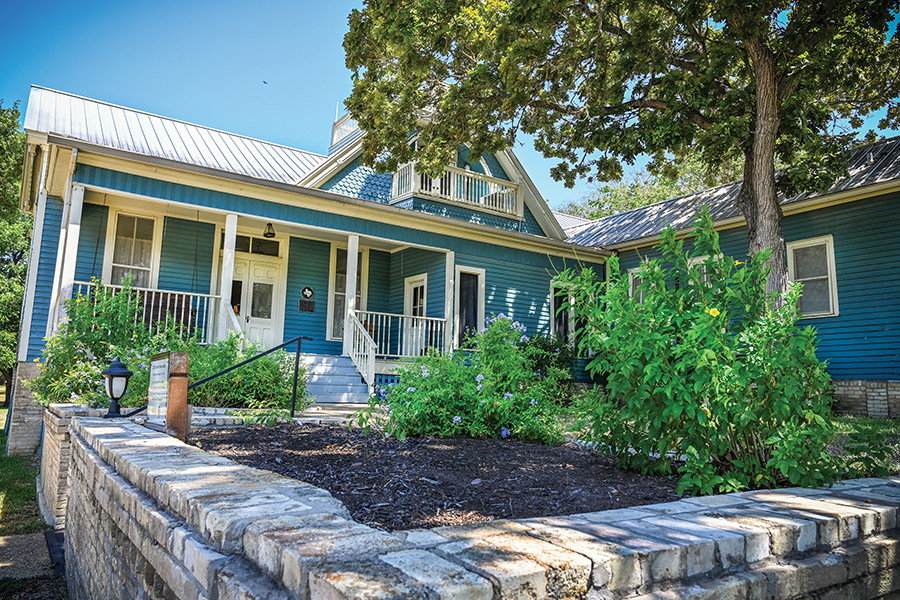
ZEDLER HOUSE
Luling, Caldwell County
The industriousness and ingenuity of German immigrant Fritz Zedler lives on in the Zedler House, adjacent to the Zedler Mill site in Luling. Zedler arrived in Texas at age 12 in 1852 with his family. Thirty-two years later, he moved to Luling and became a prominent citizen, bringing his father’s legacy of German mill work to Central Texas. He joined a group of investors to buy a mill on the San Marcos River, just south of downtown Luling, and was the sole owner by 1888. In 1900, he designed and built near the mill a 10-room, four-porch house with a “widow’s peak.” He lived there with his wife, Louise, their two daughters, and a son-in-law. Into the 1920s, Zedler Mill was the city’s only source of water and power. Cornmeal was ground there until the mill closed in the late 1950s. The home was restored in 1972 and became a Texas Historic Landmark two years later. It was purchased by the City of Luling in 2002 and renovated as a site for weddings and gatherings. Rooms, suites or the entire house can be rented. The Zedler Mill Museum just across the road is open daily and free to the public.
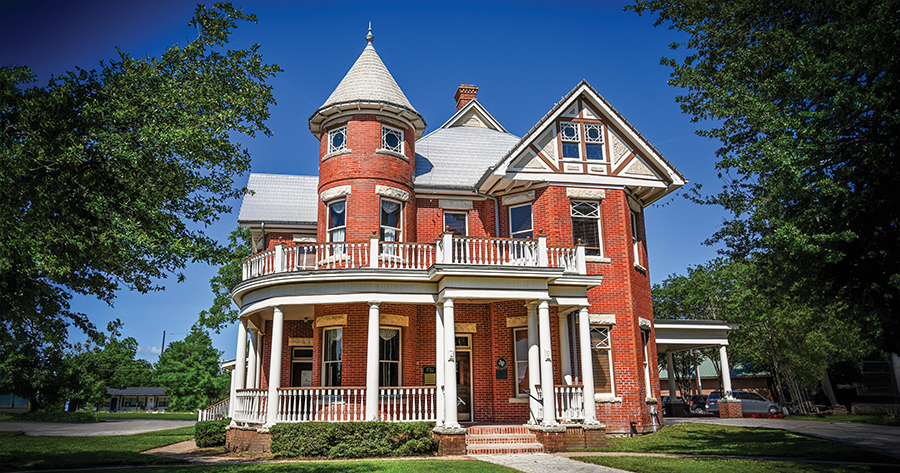
DR. I.B. NOFSINGER HOUSE
Elgin, Bastrop County
This elegant Queen Anne home — made of Elgin pressed brick and adorned with touches such as half-timbering and a turret — has long played a role in the civic life of Elgin. The house, at 310 N. Main St., was built in 1906 by a Kentucky-born doctor, I.B. Nofsinger, and designed by his wife, Mary, a pharmacist. They operated a medical practice on the first floor. The home remained in the Nofsinger family until 1978, and it later became the home of Elgin Savings and Loan. In 1991, the city purchased it and converted it into a unique city hall. The wraparound porch serves as a swearing-in spot for city officials and occasionally as a stage for local dramatic productions. The house has both state and national historic recognition. Many interior features, from doors to fireplaces, are original. “All the architectural elements and the big windows make it a really nice place to have an office,” says Amy Miller, Elgin’s community services director. From its days as a bank, it still has a drive-through window, now used by residents pulling up to pay their utility bills. Elgin City Hall is open to the public 8:30 a.m. to 4:30 p.m. weekdays.
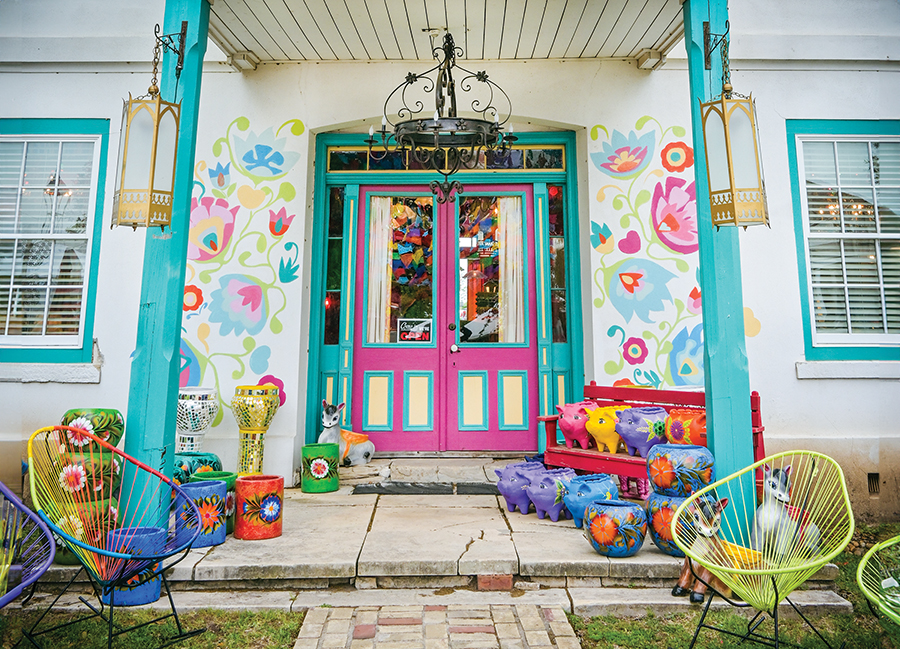
WILHELM NEESE HOUSE
Round Top, Fayette County
When the Original Round Top Antiques Fair is in full swing, State Highway 237 from Warrenton to Carmine becomes a swirl of signs, storefronts and thousands of bargain-hungry tourists. One shopping destination stands alone in its historic grandeur: The Wilhelm Neese House in Warrenton, which beckons with its festive exterior of bright paint and floral patterns. Neese, who left Germany for Texas in 1847, opened a general store in this community and sold cotton. In 1869, he began building a grand home for himself and his wife, Louisa, using stone from a nearby quarry. Neese was killed in 1872 in a confrontation with a thief at his store, but his unfinished home was completed by local merchant F.G. Cordes in 1894. The house was known for its ballroom upstairs, the site of parties and performances. Since 2016, it has been owned by Tom and Diane Conlee, who brought colorful whimsy to the exterior. Each spring and fall, during the antiques events, it becomes Punkie’s Place, Diane’s shop for handmade goods and antiques. “My husband loves the house for the history,” she says, “and I love it because it’s fabulous!” The house is listed on the National Register of Historic Places as the William Neese Homestead.
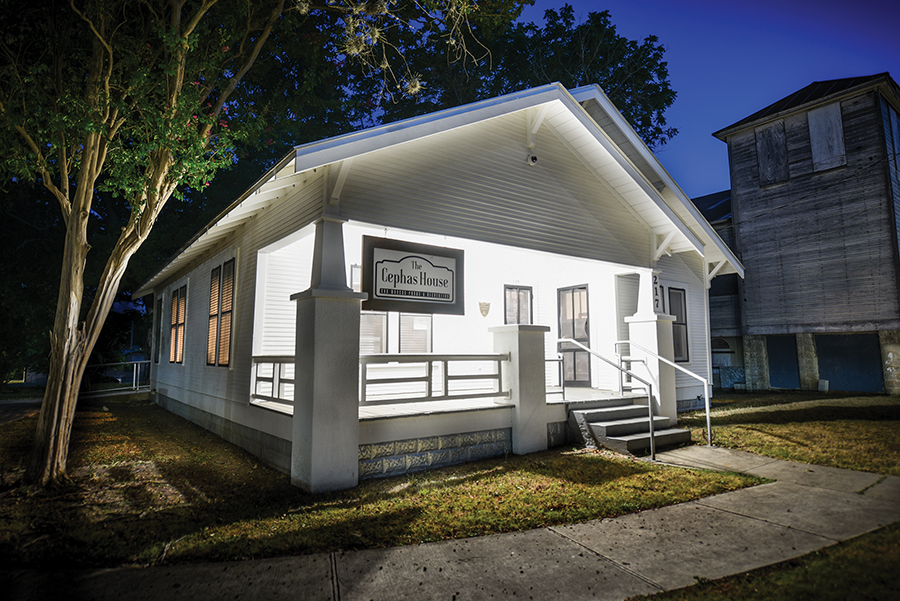
CEPHAS HOUSE
San Marcos, Hays County
Lifelong San Marcos resident Ulysses Cephas was the area’s most renowned blacksmith and shoer of horses for decades. He was also a builder and owner of rental houses, a deacon and choir leader at First Missionary Baptist Church, and the organizer of the San Marcos Independent Band, which performed around Central Texas. Cephas was born in 1884 in San Marcos to former slaves Joe and Elizabeth Cephas. He learned his trade from his blacksmith father and eventually owned his own shop at 224 Guadalupe St. He and his wife, Cora Willie Cephas, raised a family in this handsome, sturdy early-1900s home on what is now West Martin Luther King Drive. They lived in the heart of the Dunbar neighborhood, then a thriving community with many Black-owned businesses just south of downtown San Marcos. Hays County preservationist Johnnie Armstead persuaded the city to purchase the Cephas home to renovate it as a community center, which it has been since 2013. The Calaboose African American History Museum across the street tells the story of Dunbar, now a city-designated historic district.
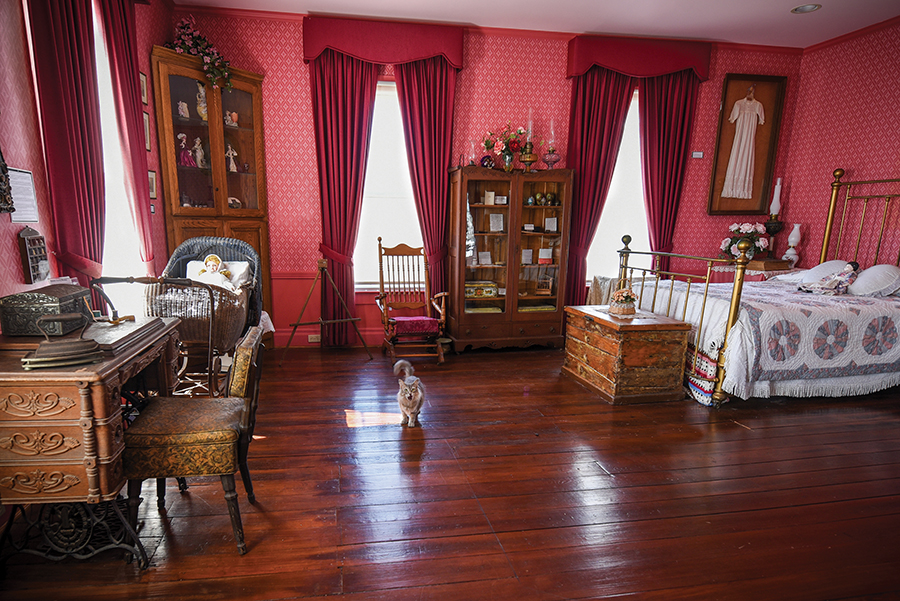
SCHUBERT-FLETCHER HOUSE
Giddings, Lee County
After the last residents move out, some old houses have the good fortune to be reborn as museums, becoming resources for the public to share and enjoy. “Historic houses have a lot of character,” says Kelita Thomas, who counts herself fortunate to work in the Schubert-Fletcher House in downtown Giddings, 183 E. Hempstead St. Thomas, tourism director for the town’s Chamber of Commerce — which has its offices in the old home — is always ready to guide visitors through exhibits of the Lee County Museum in the house. “You’ve got beautiful wood floors, amazing craftsmanship, high ceilings,” Thomas says. “It feels very much like home to work here.” Merchant August Schubert built the two-story house in a Greek Revival style in 1879. Antique furnishings, including a treadle sewing machine and a wicker pram, fill the second-story room, pictured. It is also a favorite hangout for Meow, the resident cat and “pampered lady of the house,” Thomas says. Schubert sold the house to Concordia Lutheran College in 1894, and state legislator Baylis J. Fletcher purchased it in 1900. Fletcher family members lived there until the mid-1980s. They donated it to the Lee County Heritage Society, which passed it along to Lee County in 2017. The house is on the National Register of Historic Places and is open for tours during weekday Chamber of Commerce business hours.
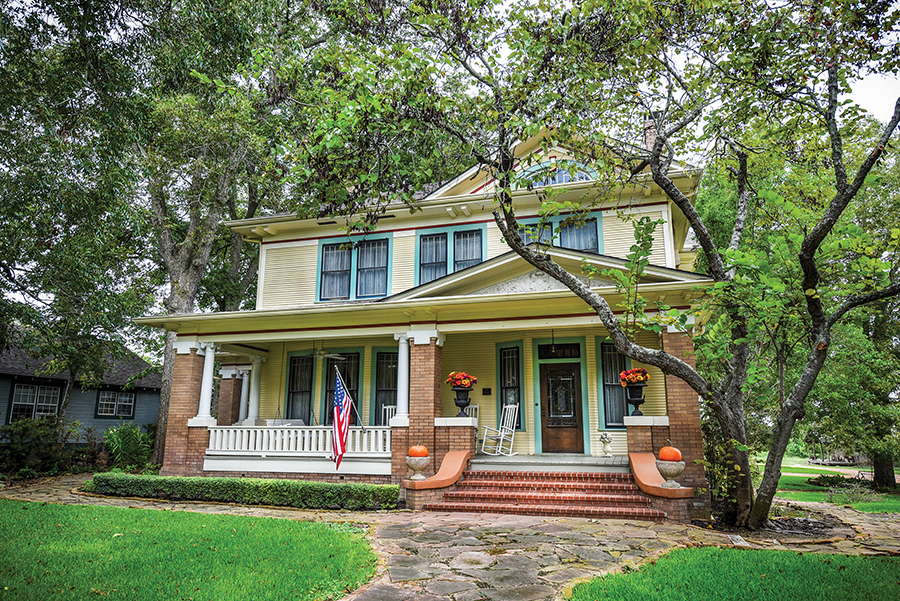
J.J. SHAVER HOUSE
Chappell Hill, Washington County
As the story goes, the first telephone in Chappell Hill was installed on the second-floor landing of the house on Main Street. J.J. Shaver, the first president of Farmers State Bank, built this two-story, asymmetrical house with a wraparound porch in 1914. It blends Prairie, Craftsman and Greek Revival architectural styles. Shaver’s descendants — including Bernice Shaver, who ran the now-closed Chappell Hill Drug Store — lived in the house until 2001. Kathy and Clay Parker have been the guardians of this treasure in Chappell Hill’s Main Street Historic District, adding only a functioning kitchen and a bathroom downstairs. Not long after they bought the house, the Parkers found its original blueprints in a closet: They framed them, and today the plans hang in the stairwell. Although it has two restored bedrooms, the couple use the home as an office, driving in from their ranch outside of town each workday to run the family business. Kathy said they enjoy pecans from the trees in the yard in the fall and, in spring, the white blooms of the massive magnolia on the north side of the house. The tree nearly dwarfs the residence. The Parkers also share the elaborately decorated house with visitors who take the Chappell Hill Garden Club’s annual Christmas Home Tour each winter.
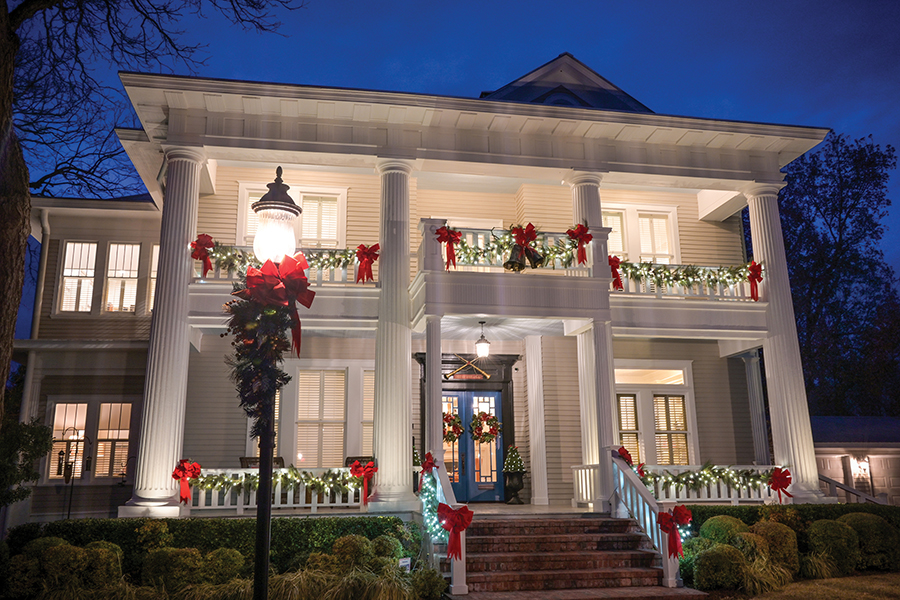
E.S. ORGAIN HOUSE
Bastrop, Bastrop County
It was a very big wedding present — a brand-new, 2½-story Classical Revival-style home, with fluted Doric columns and three coal-burning fireplaces, at 1704 Main St. in Bastrop. The house, completed in 1915, was a gift from Capt. Benjamin Darby (‘‘B.D.’’) Orgain — former county attorney and a founder of the First National Bank in Bastrop — to his son Elbert and daughter-in-law Louise. The Orgain family owned the home until 1974. Since then, a succession of private owners have cared for and restored the home, here decorated for the Christmas holidays in 2022. It was the setting for the 2013 holiday-themed movie “Angels Sing,” starring Harry Connick Jr., Lyle Lovett and Willie Nelson. It is one of three historic homes in Bastrop with the Orgain name, along with the B.D. Orgain House at 1508 Church St., built in 1888, and the house at 602 Cedar St., built before 1858, that was the longtime residence of Sarah Jane Orgain. She was an esteemed teacher who married Edmund Orgain, Benjamin Orgain’s brother. “There are over 80 homes in Bastrop listed on the National Register of Historic Places, and this is one of them. It’s beautifully restored and in pristine condition,” says Robbie Moore Sanders, author of the book “Historic Homes of Bastrop, Texas.”
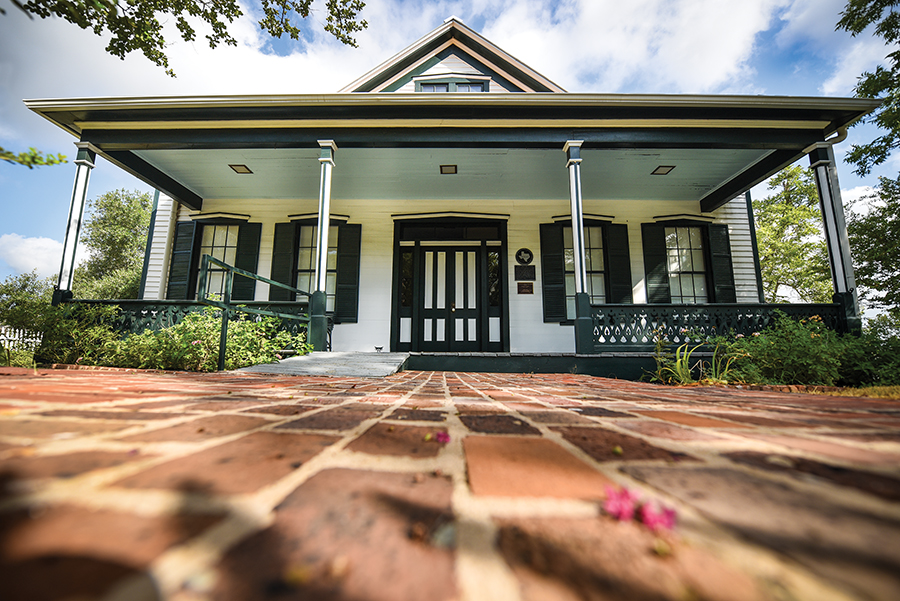
THOMAS KRAITCHAR JR. HOUSE
Caldwell, Burleson County
Does Ella Kraitchar still pace the wooden floors of the house where she was born and spent most of her life? Footsteps have been heard more than once in the old home in the center of Caldwell, at 203 E. Buck St. Some say lights are turned on when no one is there. “I’m a little skeptical about ghosts,” says Caldwell resident Linda Chamberlain, a member of the Burleson County Historical Society, which owns the Victorian cottage-style home made of cypress. She opens the home for tours, “but, I assure you, I’m not going in the house alone after dark.” Merchant Thomas Kraitchar Sr. built the home in 1891 as a wedding present for his son Thomas Jr. and daughter-in-law Mary. Ella Kraitchar, their last surviving child, moved out of the home in the 1970s. Period furnishings give visitors the feeling of stepping back in time. The house became a Texas Historic Landmark in 1983 and is also on the National Register of Historic Places. Caldwell Elementary School third-graders visit Kraitchar House every year. It is open during Caldwell’s Kolache Festival and Christmas homes tour, as well as for tours on request.
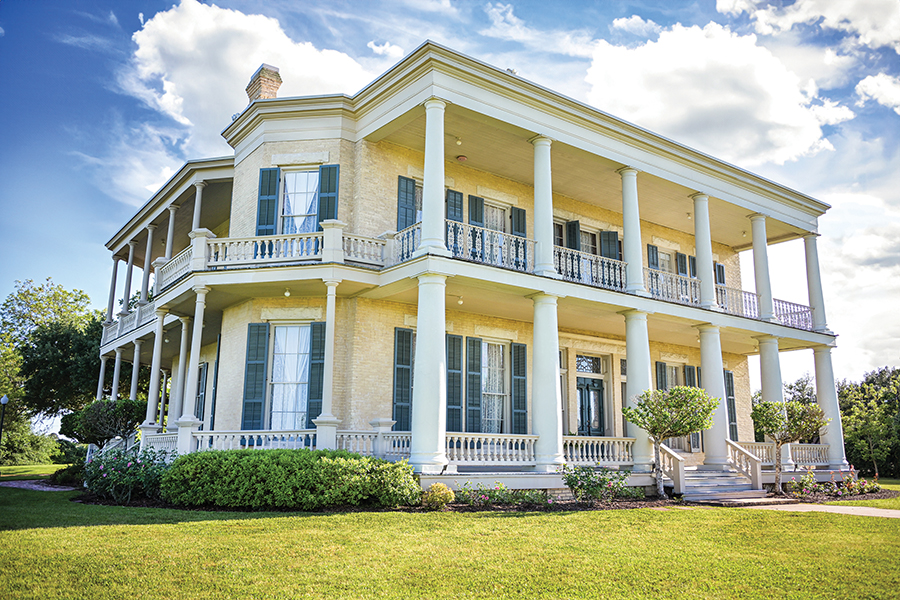
GIDDINGS STONE MANSION
Brenham, Washington County
This stately Greek Revival mansion south of downtown Brenham, completed in 1870, was built on elevated land to evade mosquitoes, which had caused a recent yellow fever epidemic. It was the home of prominent Brenham banker, lawyer and landowner Jabez “J.D.” Giddings and his wife, Ann. J.D. Giddings came to Washington County in 1838 from Pennsylvania to claim land given by the Republic of Texas to the heirs of his older brother, Giles Giddings, who was mortally wounded at the Battle of San Jacinto. The nearby town of Giddings was named for the family, thanks to their role in bringing the railroad to the region. The home, later owned by daughter Mary Louise Giddings Stone, has 11 rooms and a five-bay, two-story front porch with Doric columns. Subsequent remodeling made it the first house in Washington County with indoor plumbing. Mary Louise and her descendants lived in the home until the 1970s. In 1976 it was donated to the county’s heritage society and in 1991 it became a Texas Historic Landmark. Today, it is a popular site for weddings and events.
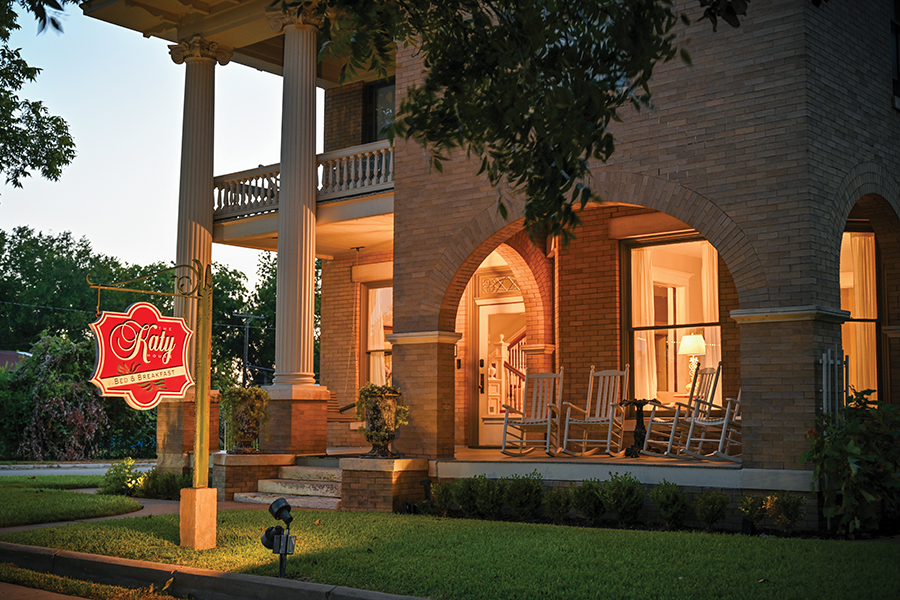
KATY HOUSE
Smithville, Bastrop County
Many longtime Smithville residents still know the grand home at 201 Ramona St. — home of the Katy House Bed & Breakfast since 1994 — as “Dr. Stephens’ place,” even though its Texas Historical Marker refers to it as the Chancellor House. J.D. Stephens was a company doctor for the Missouri-Kansas-Texas Railroad, known as the M-K-T or “Katy” line. He bought the home in 1941 after the death of its original occupant, local real estate developer and grocer J.H. Chancellor. The home’s first floor served as Dr. Stephens’ clinic through 1968. Built around 1909, the home is distinctive for its Italianate styling, Classical Revival balustrade, fluted columns and arched porch. Tiffany and Joe Prior bought Katy House in December 2019. “I just fell in love with everything about it,” Tiffany Prior says. Six rooms are available for guests, and they wake up to something special — Katy House was honored for the “Best Breakfast in Texas” in 2022 by the Texas Bed & Breakfast Association. In the backyard, you can still find a reminder of earlier occupants: the minnow tank built for Dr. Stephens’ wife, Neva, who was an avid fisherwoman nicknamed “Pete.”
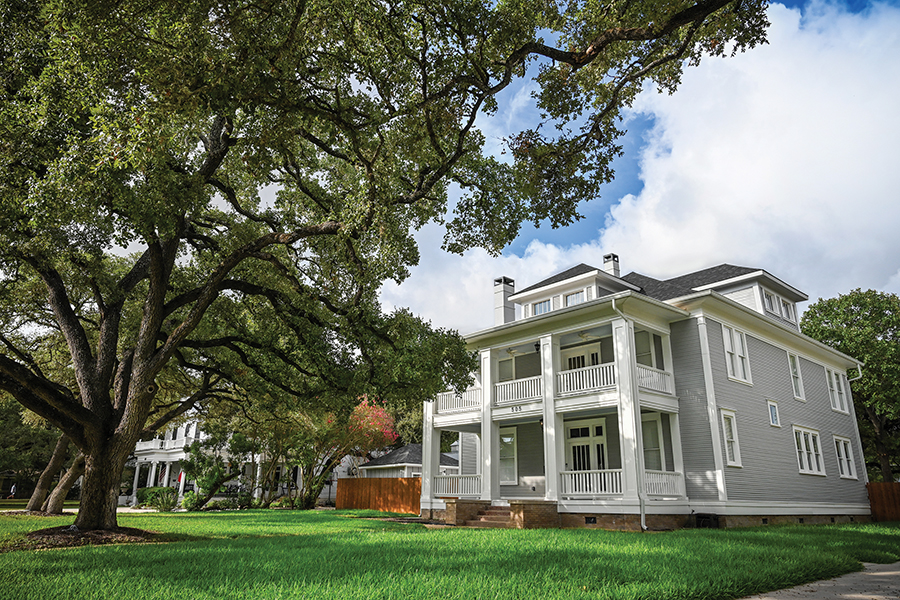
CARDWELL HOUSE
Lockhart, Caldwell County
The man who built the white house with the columns at 505 S. Main St. in Lockhart never had the opportunity to live in it. John M. Cardwell moved to Caldwell County in 1856, when he was 18. After the Civil War, he returned to Lockhart to be with his wife, Mattie, and he became a merchant with a store on the courthouse square downtown. In 1917, he had the two-story Classic Revival-style home built, but he died that year. His wife lived there until 1944. The house features four columns, 11-foot ceilings, five fireplaces and a second-floor balcony. Shaded by towering oak trees, Cardwell House was originally restored by Charles and Carol Haynes in 1979, and has had several owners. It first got air conditioning in 2012. Cassie Epperson-Jones, who grew up on the Texas Gulf Coast admiring Galveston’s grand historic homes, bought the house in 2016 to raise her school-aged children. The family converted the carriage house into a living room with a modern bathroom, put in a driveway and transformed the back porch into a laundry room. “When my daughter was in junior high, the kids used to tease her about living in a mansion,” Epperson-Jones said. “I told her, ‘Nobody who shares a bathroom lives in a mansion.’ ”
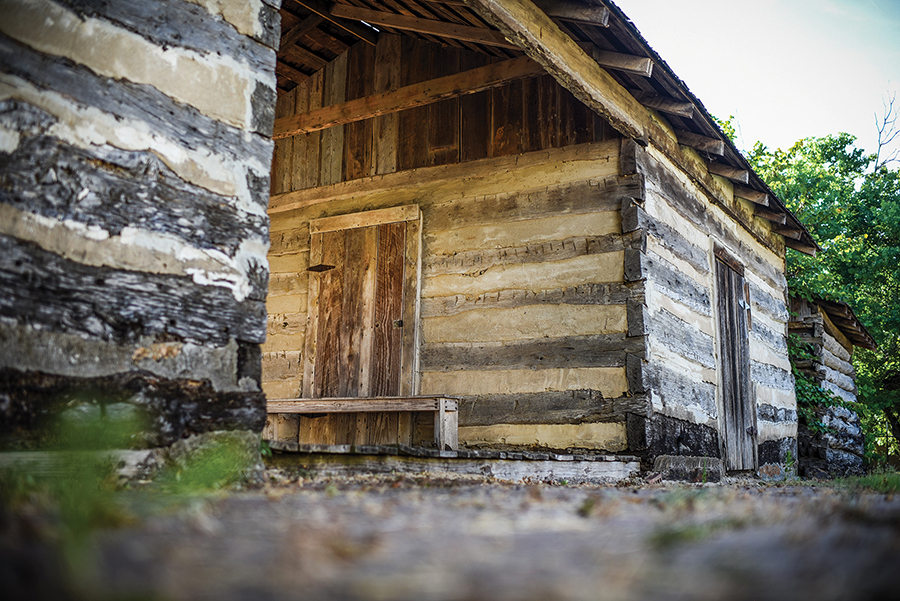
LEXINGTON LOG CABINS
Lexington, Lee County
In our nation’s bicentennial year of 1976, the citizens of Lexington — from history buffs to high school students — pitched in to carefully disassemble and relocate two pioneer cabins from the countryside in northern Lee County to the town square. Originally built several miles apart around 1850 by settlers who came to farm or ranch on the area’s open range, the two-room cabins were made with hand-hewn oak beams and had rugged stone fireplaces. They were built in the traditional dogtrot style, with a center breezeway for hot summer afternoons. Today the cabins are cared for by the nonprofit Lexington Log Cabins and Heritage Center, which opens them for school group visits and tours, and during the Lexington Homecoming festival each May. Graham Brown’s family owned one of the cabins when he was young, and the Lexington native remembers playing in and around it in the early 1950s while grownups harvested peanuts nearby. “I would sit on that hill and look around and think about the old days,” Brown recalls. You can think about the old days, too, on a visit to the cabins and the accompanying Heritage Center, which features exhibits on Lexington’s history.
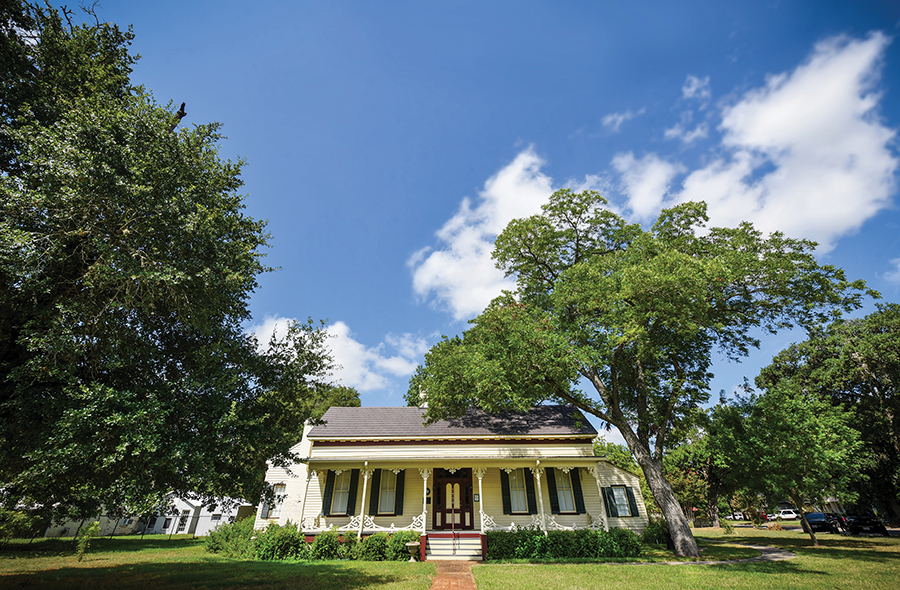
N.W. FAISON HOUSE
La Grange, Fayette County
After moving to Fayette County from Houston two decades ago, author Marie Watts became intrigued by an African American cemetery near her home in Muldoon. She learned the land for the cemetery had been donated after the Civil War by Nathaniel Faison, a wealthy white La Grange merchant and land speculator originally from Tennessee. In 2005, while flipping through old property documents with local historian Janelle Dupont at the Fayette County clerk’s office, they found a deed signed by Faison in 1870 leaving his home to his Black housekeeper, Louisiana Brown. He died later that year. “She is one of the first freedwomen in the state of Texas to own property,” says Watts, vice president of the Faison Preservation Society, which owns the home and runs a museum there. Established in the 1960s by the La Grange Garden Club, the house, at 822 S. Jefferson St., introduces visitors to the rich, complex stories of Brown, the Faisons, and race relations in the area after the Civil War. Listed on the National Register of Historic Places, the house is one of the oldest in Fayette County. Construction began in 1841. It has original furnishings and household items from the late 1880s.
How to visit area historic homes
Four of the homes in this calendar are open to the public as museums:
- The N.W. Faison House, 822 S. Jefferson St., La Grange (faisonhouse.org)
- The Schubert-Fletcher House, 183 E. Hempstead St., Giddings, site of Lee County Heritage Center (giddingstx.com)
- Kraitchar House, 203 E. Buck St., Caldwell (caldwelltx.gov, click Discover Caldwell, then Museums)
- Lexington Log Cabins and Heritage Center, 524 Fourth St., Lexington (hours vary, call Trudy Holland, 512-496-2779, for information)
You can also visit:
- Nofsinger House, 310 N. Main St., Elgin, open for City of Elgin business (elgintexas.gov)
- The Giddings Stone Mansion, 2203 Century Circle in Brenham, open for special events (giddingsstonemansion.com)
- Punkie’s Place, at the Neese House, 4218 S. H. 237 in Warrenton, open during the Round Top Antiques Fair (punkiesplace.com/ location and roundtoptexasantiques.com)
- Cephas House, 213 Martin Luther King Drive, San Marcos and the Calaboose Museum across the street (calaboosemuseum.org)
You can spend the night at:
- Katy House Bed & Breakfast, 201 Ramona St., Smithville (katyhouse.com)
- Zedler House, 1115 S. Laurel Ave., Luling (cityofluling.net, search for Zedler)

